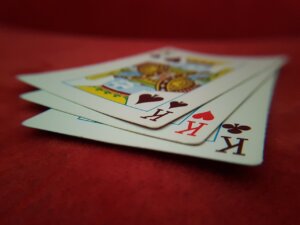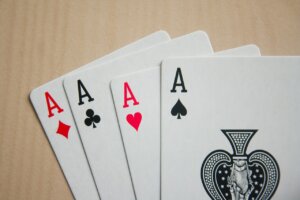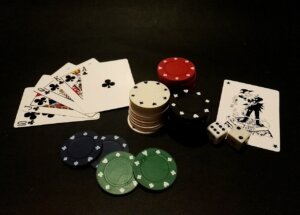In poker, One pair is when a player holds two cards of the same rank on their hand. For example, by holding two 9s, they have a pair of 9s.
Pairs are ranked according to the rank of the card. So, in our example above, the player with a pair of 9s has a higher pair than a player with, for instance, a hand with a pair of 4s. Pairs can also be referred to by their pocket cards, so in our example above, the player holding two 9’s would be said to have either “a pair of nines” or “pocket nines.”
Pairs are only sometimes winners in poker. When playing against someone who has a higher-ranking hand, your pair will lose to their hand. For example, if a player has a pair of 7s and their opponent has a pair of 10s, they will win because their hand holds higher-ranking cards. Many other poker hands are stronger than a pair, so it’s important not to get cocky and overplay one pair. For example, if a player holds a pair of Kings but the opponent has three-of-a-kind 2s, the player’s pair will lose because the opponent’s hand is of higher rank.
How Does One Pair Compare to Other Poker Hands?
When it comes to poker hands, One pair is considered a relatively weak hand. Therefore, it is only marginally better than having no pair at all. However, winning with a One Pair hand is still possible if you can read the other players at the table and make intelligent bets.
In general, it’s recommended to avoid betting too big with a One Pair hand. This is because other players are very likely to have stronger hands. If a player makes too big of a bet, they could end up losing a lot of chips. For example, in a typical variation of Texas Hold ’em with nine players, the probability that at least one player has a stronger hand than one pair on the flop is approximately 34%. This probability increases to approximately 54% on the turn and 66% on the river.
Instead, it’s recommended to try and be more conservative with betting and see how the other players at the table react. If they all seem to be folding, then taking down the pot with a small bet may be possible.
One Pair Bluffing
One Pair hands are also good for bluffing. If you’ve been playing tight all night and suddenly make a big bet with a One Pair hand, your opponents may think you have a much better hand than you actually do. This can lead them to fold their own hands, even if they might have had a chance of winning against you. Bluffing can be a risky move, but it can sometimes pay off in situations like this.
Use One pair to build other hands
Lastly, if the opportunity arises, one pair is an excellent starter for building other hands, such as Three-of-a-Kind, a Straight, or even a Full House. For example, if a player has a pair of Kings and the table shows King-King-Ace-Queen-Jack, the player can use their pair of Kings and the three highest community cards to make a Full House, Kings full of Aces. Similarly, if the board shows Ace-King-Queen-Jack-10, a player with a pair of 9s can use their pair and the five community cards to make a straight, 10-high.
While one pair is not the strongest poker hand, it can still be a valuable starting point for making stronger hands in certain situations. It’s important always to consider the strength of your hand relative to the board and your opponent’s actions when deciding how to play your hand.






